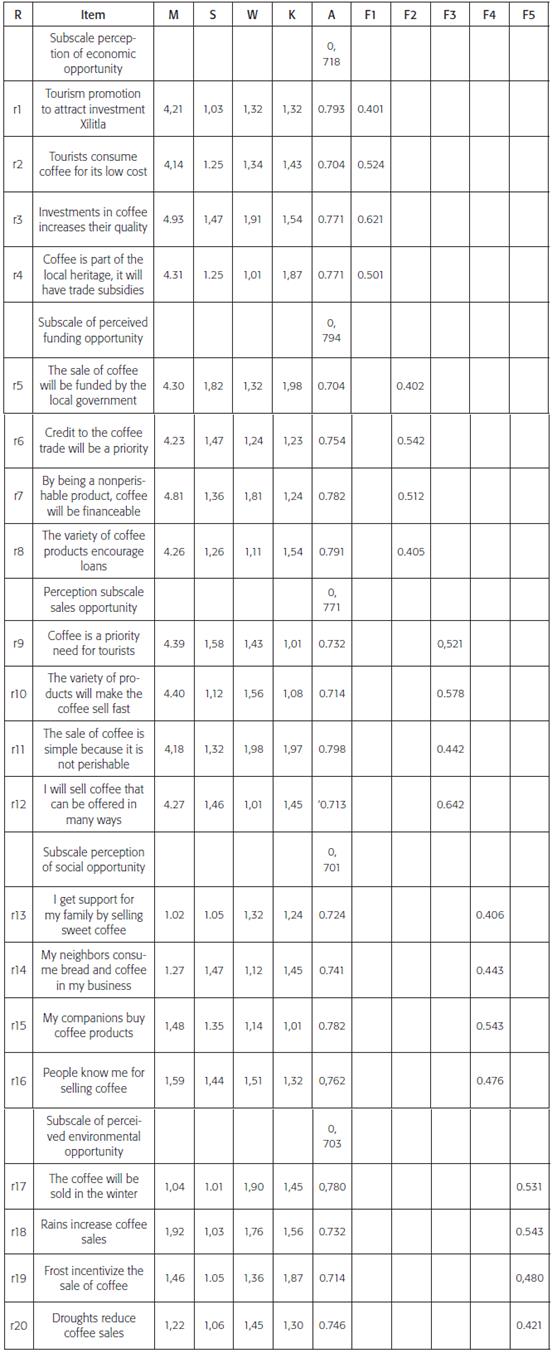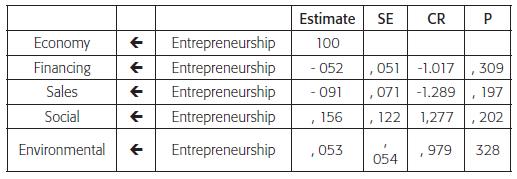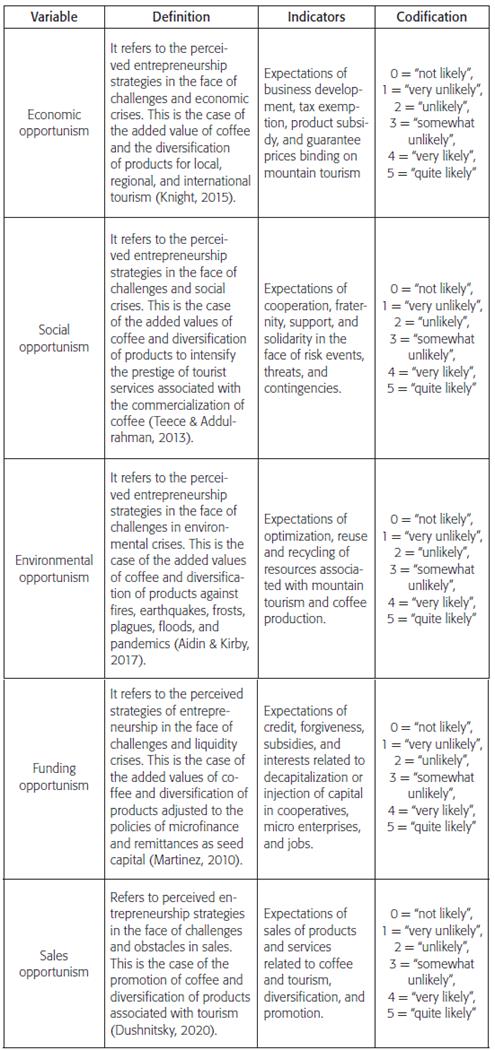INTRODUCTION
Coffee entrepreneurship, understood as a result of local business development policies, micro-financing strategies, and support programs for magical towns with a tourist cultural heritage, is a growing phenomenon in Mexico. It is estimated that around 40% of cultural tourism and coffee consumption is attracted by the climate, the quality of the service, and the local product. In the center of Mexico, the Huasteca area is distinguished by combining both tourist attractions, the mountain cultural museum, and the production and marketing of coffee. Such relationship between the denomination of magical town, its mountain tourist attraction, and coffee production explain the economy of localities, and the drive for municipal growth through entrepreneurship and cooperativism.
Within the framework of the health crisis caused by the SARS-CoV-2 coronavirus and the Covid-19 disease, the coffee business is associated with the reactivation of cultural mountain tourism, as well as the consumption of direct or derived coffee products. This phenomenon has attracted the attention of the social sciences and economic sciences, in order to anticipate synergy scenarios between tourist attraction and coffee consumption, as well as the naming of a magical town with respect to the destination's image and prestige, the quality of the products and services derived from coffee-consuming tourism.
Garcia (2016) established the reliability and validity of an instrument that measured five dimensions related to opportunistic commitment: economic, financial, commercial, social, and environmental; to explain the impact of micro credit policies on local development. The instrument discriminated the five dimensions to account for a phenomenon related to the differences between rulers and the ruled, in the face of challenges and a risky environment; landslides, fires, frosts, earthquakes, and floods.
Carreon, (2017) found differences between coffee growers with respect to risk, uncertainty, and conflict at the time of carrying out the venture with the local product in regional tourist areas. These are producers, distributors, and sellers who began to commercialize coffee from seed capital and municipal microfinance, but they differed as the factors intensified. In other words, business development policies affect local entrepreneurship, as long as problems do not increase.
Garcia (2017) interpreted the discourses and narratives around the commercialization of coffee, which were linked to the cooperation between sellers of the product, although the economic dimension was not inferred as a result of microfinance policies, but rather as an identity between migrants and natives by attributing the origin of the seed capital.
Hernandez (2018) found three factors related to entrepreneurship, lucidity, and innovation to explain the local commercialization of coffee, although the relationships suggest the inclusion of another factor, that the literature identified as opportunism, to complement the trajectory that goes from the optimization of resources to the transformation of processes. This sequence has not been addressed by entrepreneurship studies because the factors have been proposed as determining factors rather than as reflecting the phenomenon.
Bucio (2019) demonstrated the factorial convergence of entrepreneurship with respect to collaboration and ethnocentrism, considering the situation of the locality as a receiving center for migrants, in which the offer of employment and microfinance promoted local development. In other words, the labor context coupled with business development policies determined local entrepreneur-ship, although limited to groups and sectors identified with a municipal management system and community self-management.
Carreon (2019) contrasted a model in which the economic bias determined the coffee entrepreneurship in migrants, yet when local identity and employment expectations also had an impact, the perception that economic crises would not affect the local coffee trade explained the decisions to carry out a business project focused on coffee.
Muñoz (2019), following the theoretical and conceptual frameworks of habitus, fields, capitals, and capacities, contrasted a hybrid model of coffee-growing entrepreneurship, finding positive and significant relationships between the determining factors. Such sequence of axes, trajectories, and relationships meant the establishment of microfinance policies to encourage local development; mountain tourism and coffee marketing, but without considering the social image of the town being called "magical".
Carreon (2020) found that the management skills of the entrepreneurs explained their fields of prestige endorsed by product quality. In other words, the locality seems to have built a scenario of risk aversion by focusing its interest on the production and commercialization of coffee, once they identified the main attraction of the community in the image of their locality, they will ignore the influence of other factors associated with challenges and a health crisis, such as the management of production and sales opportunities.
To sum up, regarding the validity and reliability, the instruments used to measure the dimensions of the coffee enterprise have explained percentages of variance that range between 31% and 67%, which vary according to the context, the scenario, or the situation being unfavorably exacerbated. Studies related to entrepreneurship show two hegemonic dimensions: resource optimization and process innovation. It is a reflective sequence of the expectations of success when guiding cooperatives towards local development projects. In this process, the dimensions addressed determine or reflect the likely utility of a novel project.
What are the dimensions of the coffee business, assuming the impact of the health and economic crisis attributed to the SARS-CoV-2 coronavirus and the Covid-19 disease in a tourist town in central Mexico?
The null hypothesis that guides this work contrasts the dimensions reported in the literature with respect to the factors observed in the present work. Therefore, there are no significant differences between the theoretical dimensions with respect to the empirical factors.
METHOD
Design
A non-experimental, transversal, and exploratory study was conducted. Due to the fact that the reviewed studies have emphasized the reliability and validity of the instrument that measures coffee entrepreneurship, a cross-sectional study was carried out, although the contribution to these psychometric properties suggests the exploration of its dimensions, which are diverse.
Sample
A non-random selection of 300 microentrepreneurs (M = 27,3 SD = 2,1 age M = 7'892,13 SD = 345,34 USD) was performed, considering its main activity-oriented marketing of coffee and derivatives such as sweets, drinks, and bread, as well as their access to microfi-nancing registered in the municipal census.
Instrument
Coffee Entrepreneurship Scale (CES) by Garcia et al was used (2016), which includes 20 items related to perceived economic opportunity (eg; promoting the magical towns attract investment, Xilitla); perception of social opportunity (eg; I support my family by selling sweet coffee); perception of environmental opportunity (eg coffee will be sold in winter); funding opportunity perception (eg coffee sales will be financed by the local government) and the perception of sales opportunity (eg coffee is a priority need for tourists). Each item is answered with one of five options ranging from 0 = not at all likely to 5 = very likely (see Table 1).
Procedure
Delphi technique for homogenizing the meanings of the words included in the used reactants. Anonymity and confidentiality in writing, where they were also guaranteed that the results of the study would not affect their economic, political, social, or community status. The surveys were conducted in establishments marketing coffee and related products. The information was processed in the Statistical Package for Social Sciences (SPSS for its acronym in English) and Structural Analysis of Moments (AMOS for its acronym in English). The mean, standard deviation, Cronbach's alpha, chi square, KMO, factor weights, betas, and residual goodness of fit were estimated.
Analysis. Because reliability and validity are parameters that require previous statistics such as normality, adequacy, and sphericity, the internal consistency of the instrument was estimated with the Crombach alpha parameter, which indicates the assimilated measurement of the sample to entrepreneurship in various dimensions, as well as the validity or convergence of the indicators in latent factors. Once the psychometric properties were established, the relationships between the factors were carried out, assuming that the normality, reliability, and validity requirements were met.
RESULTS
The internal consistency of the overall scale (alpha 0.724) and specific subscales (economy alpha of 0.718, financing alpha 0.796; sales alpha 0.771; social alpha of 0.701, environmental with alpha 0.703) reached Cronbach alpha values higher than 0.700 (see Table 1).
Table 1 Descriptive, reliability, and validity of the instrument

Source: Elaborated with data study; R = Reactive, M = Mean, S = Standard Deviation, W = Sweetness, K = Kurtosis, A = Alpha with excluded value item. Extraction method: principal components. Sphericity and adequacy [KMO = 0.796; X2 = 346.456 (23gl) p = 0,000j. F1 = Perception of Economic Opportunity (32% of the total variance explained), F2 = Perception Financial Opportunity (22% of the total variance explained), F3 = Perceived Opportunity Sales (16% of the total variance explained), F4 = Perceived Social Opportunity (10% of the total explained variance), F5 = Perception of Environmental Opportunity (3% of the total explained variance). Each item is answered with one of five options ranging from 0 = "not at all likely" to 5 = "very likely". Each alpha value corresponding to each item is excluding the weight of internal consistency.
Regarding the adequacy and sphericity [KMO = 0.796; x2 = 346.456 (23gl) p = 0,000j these reached minimum values necessary for exploratory factor analysis of principal components with varimax rotation and establish the factors correlated with items from values above 0.300
Table 2 Dependency relationships between the factors and the construct

Source: Elaborated with study data; Regression weights: SE= Standard Error, CR= Critical Ratio parameter estimate divided by standard error, p = level significance.
Five factors relating to economy (32% of the total variance explained), finance (22% of the total variance explained), sales (16% of the total variance explained), society (10% of the total variance explained), and the environment (3% of the total variance explained) were established.
Therefore, the dependency relationships between established and emerging construct factors indicate that factor is the perception of social opportunity which reflects the construct of perception of entrepreneurship (β = 0.47), followed by the perception of economic opportunity (β = 0.30), and perceived environmental opportunity (β = 0.16).
Finally, the values of goodness of fit and the residual confirm the acceptance of the null hypothesis about the adjustment of the theoretical dimensions with respect to the empirical dimensions of perception of entrepreneurship [X2 = 1.335 (5GL) p = 0.935; GFI = 0.982; AGFI = 0.947; RMSEA = 0,000j.
DISCUSSION
The contribution of this work to the state of the question lies in the establishment of the reliability and validity of an instrument that measured coffee growing in a town in central Mexico, although the research design limited the results to the sample, suggesting the extension of the work to other settings.
In relation to the studies that used an instrument to measure the internal consistency and the dimensions of the enterprise, ranging between 0.61 and 0.76, as well as the percentages of explained variance from 31% to 67%, the present work has shown moderate internal consistency and more dimensions, three previously documented and two specified. It is about financing and sales opportunism, that derive from economic opportunism, but which are distinguished by their degree of specificity in the face of risky events.
Research lines concerning the specification of the dimensions, relative to opportunism, will allow anticipating contingent scenarios of entrepreneurship. This means that localities seem to move towards risky situations and adapt to these limitations, although they are also indicative of dependence on business development policies in tourist locations.
The reliability of the instrument, which exceeds the indispensable minimum of internal consistency, suggests the concerning lines of research increase the values with the inclusion of more reagents. This is so because the percentage of variance suggests the specification of the economic undertaking, which the literature has related to subsidies and condonations in terms of municipal services.
The validity of the instrument that measures local entrepreneurship is also determined by the specific dimensions that the literature has identified as indicators of the more general dimensions. This question suggests that the relationships between producers, sellers, and managers have reached a degree of consolidation and sophistication in which the economic dimension prevails over the social or environmental dimension, as well as its dissemination in factors related to sales and financing, but also with respect to subsidies and exemptions.
CONCLUSION
The contribution of this work to the state of knowledge lies in establishing the reliability and validity of an instrument that measures five factors related to the perception of entrepreneurship in a town in central Mexico.
Future research regarding other factors that the model did not include, nor estimated, could be carried out if it is considered that the marketing of products and services derived from coffee is an economic activity driven by enterprise development policies and micro financing, and part of social and community uses and customs of the area of study.
In addition, environmental conditions also play a decisive role in perceptions of entrepreneurship in general agricultural products and services, and perceptions of opportunity around coffee.
In this sense, the ecological validity consisting of systematic observation of the habits and customs, as well as their correlation with scales measuring perceptions of opportunity, would provide a comprehensive view of the phenomenon which is coffee, environment, management, marketing, and consumption.
Therefore, the specification of a model, and the estimation of indicators that explain the peculiarities of entrepreneurial localities confined to coffee is necessary, because, although the venture is a structure of perceptions, decisions, and strategies, the project success depends on local specificity.
This is the case of the sectors dedicated to the sale of coffee and marketing of its products and related services. The characteristics of each sector require a thorough analysis of the customs that make survival possible by selling coffee. In this sense, female heads of household are an example of groups dedicated to retail and entrepreneurship of diversified products, including coffee.
Exploring values, perceptions, and beliefs of the household heads dedicated to coffee explain and anticipate scenarios that allow environmental, economic, political, and social crisis, but also ones of resilience and social entrepreneurship.















